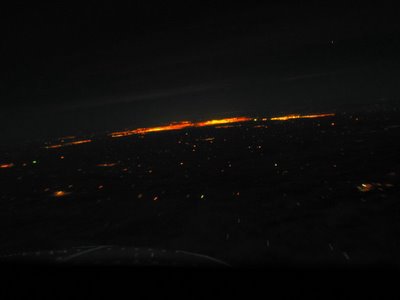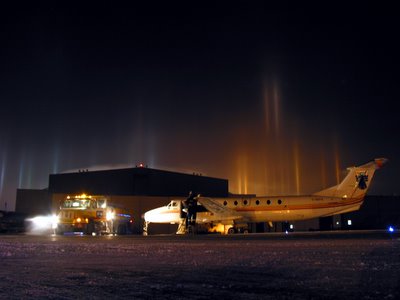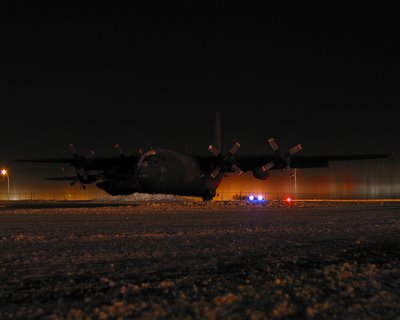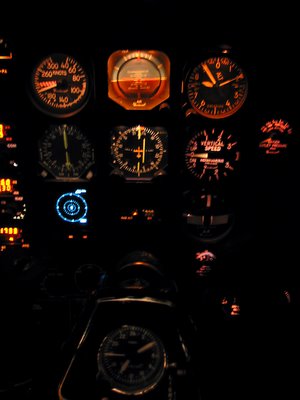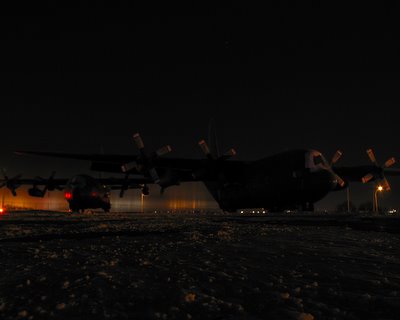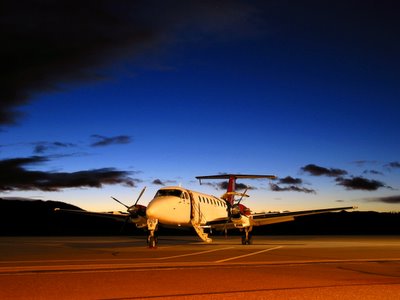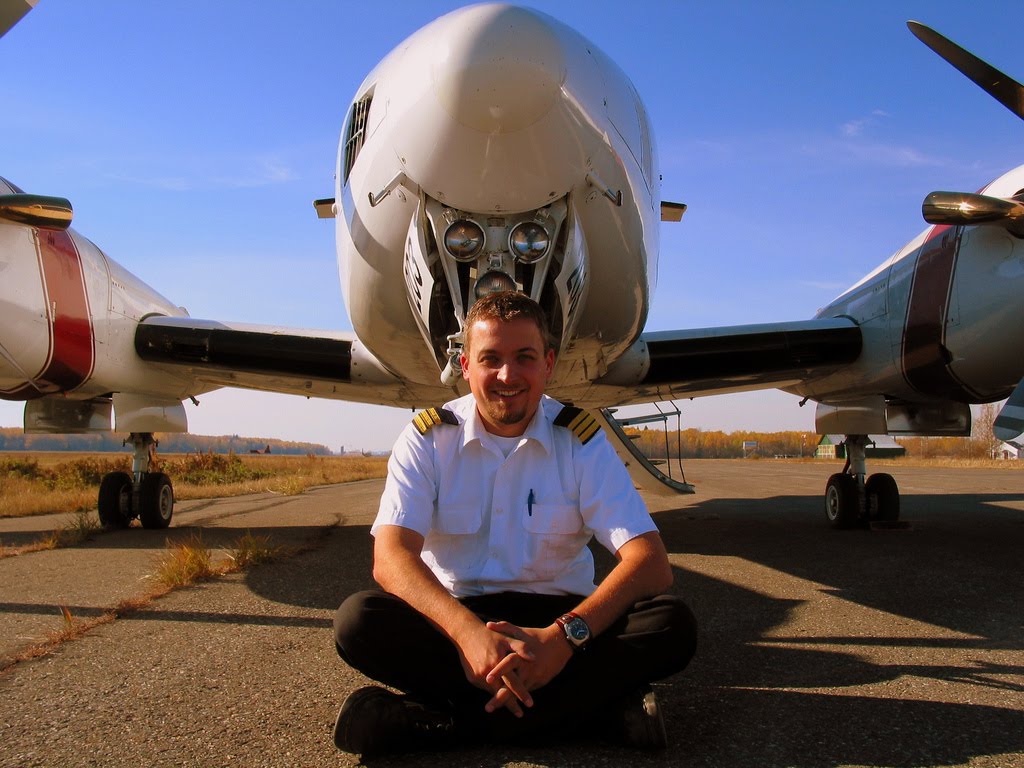Thursday, December 22, 2005
Wednesday, December 21, 2005
Sunrise over the Praries
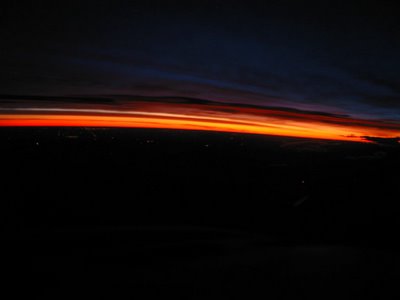
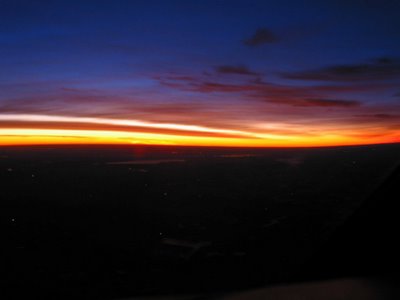
Posted by
Lost Av8r
at
12:16 PM
2
comments
![]()
Sadness
The loss of some fellow aviators always saddens me. My sincerest condolences to the Families and friends of these two pilots, and to the people at Navair.
Courier plane crash kills 2
Both pilots were killed when a twin-engine charter courier plane crashed less than a minute after takeoff from the Terrace airport on Tuesday evening.
Northwest Regional Airport manager Laurie Brown says the Nav Air Charters plane went down in a wooded area south of the airport shortly after 6:30 p.m.
"My staff noticed a fireball just off the end of the runway," he said.
"When I arrived at the airport about 10 minutes later the RCMP, the Terrace Fire Department and most of the responding agencies were already on the site and being escorted down to the crash scene."
The firefighters were able to put out the flames, but could not rescue the two people on board.
Transportation Safety Board investigators have been called in to investigate. Brown says that while the weather was overcast, visibility was about 15 kilometres when the plane went down.
The aircraft was on a regular flight to Vancouver
The names of the pilots have not been released.
God speed....
Posted by
Lost Av8r
at
11:40 AM
0
comments
![]()
Tuesday, December 20, 2005
Christmas can't come quick enough.
Last night was the craziest post trip so far, with two back to back trips. I flew well into the morning daylight. Tonight is shaping up to be a long one as well. I can't wait for this week to be over.
Post office marks final days of holiday mail crush
Last Updated Tue, 20 Dec 2005 07:49:34 EST
CBC News
Canada Post operations across the country Tuesday were bracing for another hectic day at the height of the 2005 holiday mail season.
While a normal day usually sees the post office handle an estimated 38 million pieces of mail, the volume during the holiday season climbs to as high as 45 million pieces of mail every day.
Don Keiley, Canada Post letter carrier.
There are ways of getting your mail through. But it means paying extra. There's Priority Post or other overnight couriers. But with every passing day, even that opportunity slips by.
The post office says Monday was the busiest day of the year, but it's expected Tuesday will be almost as busy.
Cards and letters
Canada Post estimates that, on average, Canadians send two dozen cards or letters to friends and family over the holidays.
In 2004, the post office says it delivered more than 650 million letters, cards and parcels during the holiday period.
Don Keiley, one of Canada Post's thousands of letter carriers, says that after 25 years on the job he knows not everything gets through on time – and it's not his fault.
"Sometimes you see 'Do not open until Dec. 25' on the package. The postage will be Dec. 27, or something," said Keiley.
Posted by
Lost Av8r
at
11:55 AM
2
comments
![]()
Saturday, December 17, 2005
Friday, December 16, 2005
Tuesday, December 06, 2005
The Mail Must go Through.....
 FL180, 46 miles Southwest Edmonton, Direct VARSY, enroute Edmonton to Vancouver
FL180, 46 miles Southwest Edmonton, Direct VARSY, enroute Edmonton to VancouverThe night skies are usually pretty empty, with the exception of cargo/courier/mail flights. The normally steady squawking of the radio, with the many pilots and controllers playing our game of air traffic control, is replaced with an almost eerie silence. We'll check in with one controller and hear nothing from him or her again until they hand us off to the next sector. I've had nights where I could count on one hand the number of other aircraft I hear in the sky. The upside of this silence is that you can pretty much request anything from air traffic control and get it. This results in much more direct routings. Departing Edmonton for Vancouver we would normally end up flying towards a point 50ish miles Northeast of Vancouver called BOOTH. From there we would end up flying a published arrival into Vancouver (oddly enough known as the Booth arrival). In the middle of night however, most aircraft are given direct to VARSY, an intersection just off of Point Grey (near UBC). By the time we get there ATC usually has us down at 5000' and we've got the airport in sight, making for an easy visual approach onto 08 right.
Last night was my first night of eight, I'll do this trip for the next three nights, have the weekend off, then do it all over again next week. With each passing day closer to Christmas, I'll sure be getting my exercise in (I'm in dire need anyways)
Posted by
Lost Av8r
at
2:52 PM
0
comments
![]()
Monday, December 05, 2005
New places

Here's a nice map of the places I've flown into with NT so far.
For those of you that don't have it or haven't seen it, I used Google Earth for the image. It's an amazing program.
Posted by
Lost Av8r
at
12:40 PM
0
comments
![]()
Sunday, December 04, 2005
The Raytheon Beechcraft 1900 Airliner
The 1900 was Beechcraft's chosen model for entry into the regional airliner market in 1979. The main idea was to take the already popular Beechcraft King Air 200, stretch it out and soup it up, which is pretty much what Beech did. The 1900 first flew on September 3rd of 1982 and received FAA certification in November of 1983. Although there have been four different models of the 1900, only two have had commercial success, the 1900C, and the 1900D. The 1900C was introduced in February of 1984. Through the course of it's production it was also offered in a Military Transport, Maritime Patrol, and Electronic Surveillance version (Military Designation C-12).
Beech announced the improved 1900D in 1989 and switched production from the 'C' model to the 'D' model in 1991. According to Raytheon Airline Aviation Services, nearly 700 Beechcraft 1900's have been produced and are operating in over 50 countries. In Canada alone, there are 20 'C' models and 46 'D' models. In the United States, Mesa Air Group has ordered 118 1900D's. Production doesn't appear to be slowing any time soon (maybe we're in for an updated model??)
Of the 66 1900's in Canada, I fly three 'C' models and up to 15 'D' models, although it's usually one of two. The 1900C is a two crew, 19 passenger airplane. Seating is eight rows of two seats, single seat on each side and one bench seat of three at the last row. The over 57 foot long airplane is carried into the air by two Pratt & Whitney Canada PT6A-65Bs each generating 1100 Shaft Horsepower. Each PT6 spins a four-bladed, constant speed, fully reversing Hartzell composite propeller. Depending on the cruising altitude, the 1900C burns between 700 - 900 pounds of fuel per hour, which takes us through the air at around 255KTAS. In the wings we can take upwards of 4400 pounds of fuel. All this gives us a range of around 1400NM. The 'C' Model typically weighs 9500lbs empty and has a maximum take-off weight of 16,600lbs.
The 1900D, being the newest design, has a few added features compared to the 1900C. The most noticeable of which is a higher cabin, allowing more headroom and more comfort getting in and out of the airplane. Seating is similar to the 'C' with the addition of a lavatory. The 'D' also carries some extra jam, sporting a pair of PT6A-67D's each producing 1279 Shaft Horsepower. The larger engines do burn a little bit more fuel, typically around 100lbs more per hour. However, the 'D' also cruises slightly faster at 275KTAS so the range is comparable to the 'C'. With some more power comes a change in weights. The empty weight of the 1900D is around 10675lbs, with a max takeoff weight of 17120lbs. The panel is slightly more advanced then previous Beech models. In front of each pilot is two screens referred to in the biz as 'CRTs' which form an important part of the aircrafts EFIS system.
The EFIS, or Electronic Flight Information System, basically replaces classic instrument gauges with computer screens that display the same information the gauge does in a more clear fashion, plus addition information to make the pilot's job a little easier. Almost all aircraft being built these days seem to have EFIS systems, even Cessna 172's. An EFIS system can consist of just one small screen replacing only one gauge, to six or more large screens replacing almost every gauge on an instrument panel.
- Newer Model 747-400/ER with modern EFIS system
- Brand new Airbus A380 cockpit with nine CRT screens
- Beechcraft 1900D panel with the regular four screens
- Beechcraft 1900C panel
Another feature of the 1900 series that is new to me is the pressurized cabin. The 1900, both 'C' and 'D', have a service ceiling of 25,000 feet. The aircraft is pressurized to allow us to climb to, cruise at, and descend from higher altitudes. Pressurization is very simple system. Basically, we take (or bleed) air from the aircrafts turbine engines and force it into the cabin. The cabin is designed in such a way as to allow minimum air to escape from inside the cabin. Depending on the design, each aircraft type has different pressurization limits. The 1900 can hold a sea level cabin till around 11,000 feet, meaning that we can climb from sea level, up to 11,000' and descend back down again, and you wouldn't feel it in your ears at all. From 11,000' up to 25,000', the cabin altitude slowly climbs to a maximum of around 9000'. So although the aircraft may be cruising at 25,000 where the air is quite thin , the air in the cabin has an density similar to the start of the highest ski runs at the Lake Louise Ski hill. We also have control over how fast the cabin altitude changes. So though the airplane could be descending at a rate of 2000 feet per minute, the cabin could, and normally does, descend at 500 feet per minute providing a much more comfortable decent for crew and passengers.
The 1900 is a very fun airplane to fly and offers a range of options and possibilities to pilots and operators. We routinely operate out of the Vancouver International Airport, or YVR, a busy, fast paced airport, up to numerous gravel strips in Northern BC, the Yukon and Northwest Territories. Should be fun times ahead....
Posted by
Lost Av8r
at
3:39 PM
7
comments
![]()


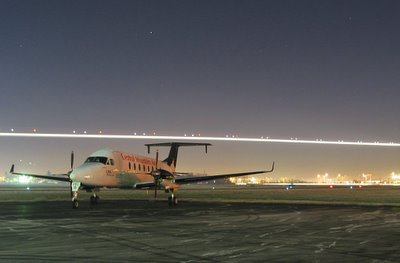 CMA 1900D awaits another day of flying while a Skyservice Airbus approaches runway 26 left.
CMA 1900D awaits another day of flying while a Skyservice Airbus approaches runway 26 left. Cathay Pacific 747 about ready to throttle up for take-off, 26 left
Cathay Pacific 747 about ready to throttle up for take-off, 26 left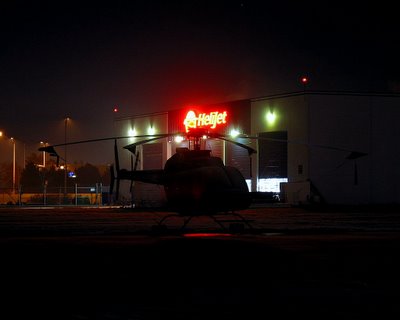 Whirly Bird infront of the Helijet hanger
Whirly Bird infront of the Helijet hanger


